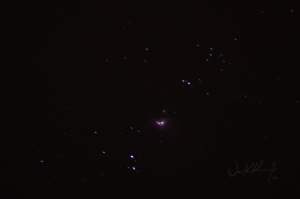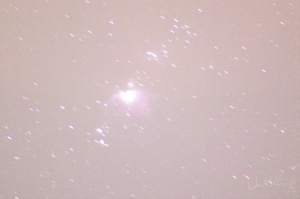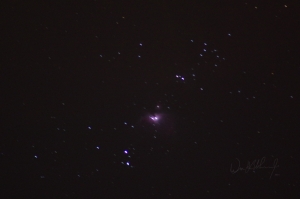To paraphrase the narrator in a YA fantasy trilogy, “Say what you will about the Pentax K3. Say that the K3 is fast.”
All images here are shown without any post processing other than to convert from RAW to JPEG. I did resize them smaller to save space but you can still see the noise and M42 for comparison.
Sunday I got up about 0300 to get a drink of water and looked out the window at the night sky. It was so clear, the stars were so bright, I could see Orion, and it was 30° F.
I went back to bed. I lay there, thinking how great the night sky was. I thought about my new camera and how it would be a great chance to check ISO vs shutter speed. I thought about how I would set up that test. I thought how Orion was right there. I thought how I really should go out and take some astrophotos.
After the third time through all that, I thought, “Geez! Quit thinking about it! If I’m going to think about it this much, I should just get up and do it!”
So I did.

M42, the Orion Nebula, aka the Great Nebula in Orion, taken with my new Pentax K3, 400mm, 5 sec., f/5.6, ISO 1600.
I mounted my Tokina 400mm on the K3, set up the tripod, connected the cable release, and went to work. My plan was simple: to run a series of shots to explore the results of different shutter speeds applied to each available ISO suitable for astrophotography.
First of all, this was from my driveway, which is not exactly a dark sky site. The light pollution isn’t all that bad, fortunately, but it’s there: you can’t see the Milky Way, but you can make out M42, the Great Nebula in Orion, as a fuzzy patch.
Given the 400mm’s small field of view, I decided to make M42, the Orion Nebula, my target because it was right there in plain sight, at a comfortable angle, and easy enough to line up on. Since this was just a test to see what I would get, I set up everything and did the shooting without checking each image immediately afterward. After all, I just wanted to see what each combination of ISO and shutter speed would give me. Plus it was 30° F and getting colder.
From experience using my K10D, and to some extent my *ist DL, I knew that I needed to expose for 10 or more seconds to get anything. I wanted to see how much noise there was at the higher ISOs. I decided that I would test with the following string of shots:
ISO: 51200, 25600, 12800, 6400, 3200, and 1600
Shutter speed: 30, 25, 20, 15, 10 seconds
The remaining variables were constant: aperture was wide open at f/5.6 and the focus was manually set. Since this 400mm doesn’t have an autofocus or auto-aperture, the K3 required me to manually enter the focal length. There was no setting on the K3 for 400mm but there was 600mm so I used that. Afterwards, for just the photos posted here, I used an EXIF editor to correct the reported focal length (changed from 600mm to 400mm) and effective focal length (changed from 900mm to 600mm).
The first new thing I played with was the focus. The Pentax K3 has Live View, and I was eager to try that. My 400mm is fully manual, so I set the camera to manual focus mode. Then I made sure the aperture ring was turned to 5.6, wide open. Next I focused through the eyepiece as best I could, triggered Live View and zoomed in on one of the stars visible. Watching the Live View, I adjusted the focus ring on the 400mm until I had the sharpest possible view of the star. I don’t think it was perfect, but it was definitely at the best possible focus.
The next step was to compose my shot. I was using a cable release to avoid any shaking from pressing the shutter release. For the timing, I wanted it to be consistent, so rather than using Bulb mode I used Manual mode and set the shutter speed to each of the desired values as the shoot went on.
I started with ISO 51200 and 30 seconds. Then I went to 25 seconds, 20 seconds, 15 seconds, and finally 10 seconds. At that point, I dropped the ISO to 25600 and worked my way back up the exposure times. Next, ISO to 12800 and downward on the speeds…you get the idea. I shot all the times against each ISO before changing ISO settings.
At the top of this post I mentioned that the K3 was fast. I’m used to every 30 second exposure needing 30 seconds to store the image to the SD card. Even with my old, non-high speed SD cards, storage to the card even with noise reduction on was still well under 30 seconds. It even seemed to speed up as the shoot went on, perhaps due to the cold?
While changing the ISO, I accidentally went to 5 seconds exposure when I moved the wrong wheel. I was about to change it back to 10 seconds when I decided, “Why not?” So for the end of the downward run at 3200 and the upward start to 1600 ISO, I had two 5 second exposures.
It wasn’t until the next later that morning that I actually looked at the pictures to see what I got. The results, as they say, were nothing short of astounding. For one thing, I flat out did not expect to get the purple/pink of the nebula in the images. I simply had never tried imaging M42 with the 400mm before. Hades, I hadn’t even expected that simply with the 400mm I could achieve a “classic” image of M42! I thought you needed a big telescope for those.
At only 5 seconds of exposure at 1600 ISO, I fully expected the whole image to be black, with maybe a couple of stars showing up. That was NOT the case and I was floored with the result.
The unprocessed (other than to convert from RAW to PNG) 1600 ISO 5 second image is at the top of this post. Even the 3200 image below is awesomeness.
There is more noise with the 3200 than the 1600 ISO, as would be expected, but more of the nebula is visible in the 3200 ISO shot, again as expected.
At first I didn’t expect to see star trails, but then I realized that the field of view through the 400mm is so small that it would take less exposure time for the stars to move across the image than for, say, a 135mm lens. Or a 50mm.
At the higher ISOs, the image is actually washed out from being overexposed! I absolutely did not expect that. Things really only start getting visible in the 10 second 51200 ISO exposure.

M42, the Great Nebula in Orion, buried in the overexposure. This is the first image (see text) where M42 is truly visible in a test image.
Pentax K3, 400mm, f/5.6, 10 sec., ISO 51200.
Working through the images afterwards, it was very noticeable that there is a line in the sand related to noise and it’s at the 12800 ISO vs 6400 ISO point. This is clearly evident in the two images below.

Showing the dividing line between ISO 12800 (left) and ISO 6400 (right). This is the point where the noise level really drops between ISOs. To either side of this line the noise level is gradual, here it’s somewhat abrupt.
All in all, I am very pleased with my new Pentax K3 camera. I certainly didn’t expect to get such a “classic” image of M42 with just the K3 and my old manual 400mm Tokina. And with the pink/purplish glow of that nebula, to boot! This camera has several tools such as internal stacking that are ideal for astrophotography and I’m really excited to play with them.
Hmmm. I wonder what’s possible with my Classic Celestron C8 mounted on the camera? Or even just with the K3 plus 400mm piggybacked for tracking. ISO 1600 for 3 seconds each, stacked? ISO 3200?
I can’t wait to get out and try again now that I know what this Pentax K3 is capable of.
The best of the season to you all!
See you next year.
